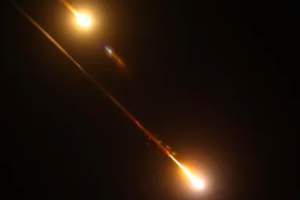Excited for Black Panther? So are we. Which is why we’re rolling out obsessive coverage with Black Panther Week.
How many did you catch? How many did you miss?
Black Panther is here, and in typical Marvel fashion the movie is brimming over with little nods and Easter eggs. Some tie the movie in with the wider Marvel Cinematic Universe, others nod to the comics on which it’s all based.
You no doubt spotted a few. We no doubt missed some. Part of the fun with these movies is poring over the minor details and connecting dots, then comparing notes with the rest of the MCU-loving world.
So! Let’s compare notes.
Vibranium
This one’s hard to miss. Black Panther‘s African nation of Wakanda owes much of its secretly space-age technology to one element in particular: vibranium.
The lingering remains of an asteroid that crashed into Earth long ago, Wakanda is centered around a vein of vibranium that’s deep enough that it could be mined for thousands of years. But this isn’t vibranium’s first appearance in the MCU.
It’s the material Howard Stark used — consuming the U.S. military’s entire supply of the stuff in the process — to create Captain America’s shield, the same one he abandoned at the end of Captain America: Civil War. It’s also what led to Ulysses Klaue losing his arm, when he dealt his own stolen supply of Wakandan vibranium to Ultron in Avengers: Age of Ultron.
The alien origin of vibranium wasn’t always known in the comics, but Black Panther makes it clear that some people on Earth do know how it got there. In the more recent comics, it’s Captain Marvel who first confirms where it came from.
We know the upcoming Captain Marvel movie is set during the ’90s, well before the present-day events of the MCU. Could she be the reason Wakandans are aware of the origin of their most valuable resource?
Hatut Zeraze
The term comes up again and again throughout Black Panther, in reference to certain Wakandan warriors: “War dogs.”
Nakia is a war dog. She’s an expert in spycraft, one of many Wakandans dispatched throughout the world to keep an eye on happenings beyond the borders of their African nation. But you may not know that these war dogs play a key role in the comics.
Wakanda’s comic book “Dogs of War,” better known as the Hatut Zeraze, is a secret police force of spies and assassins. T’Chaka is responsible for the spy organization’s creation, but years later T’Challa shuts it down because of the extreme actions of its leader, White Wolf.
If you’ve seen Black Panther, you should recognize that name: It’s how the group of Wakandan children refer to Bucky Barnes during his post-credits scene. In the comics, White Wolf is a white man who was left an orphan when his parents died in a plane crash inside Wakanda’s borders. He possesses powers similar to those of Black Panther.
The post-credits scene suggests that the MCU may be setting up Bucky to be a re-tool of White Wolf. He’s seen working with Wakandan forces in the Avengers: Infinity War looks we’ve gotten so far, and we know MCU Bucky has a background in spycraft. It’s very possible the White Wolf mantle follows him, in some form, into the events of Infinity War.
Everett K. Ross
Martin Freeman’s MCU character, Everett K. Ross, may have first popped up in Civil War but his comic book origins are rooted in Black Panther stories. Ross most significantly appeared in books penned by Christopher Priest, who inserted the character into his 1998 Black Panther run as the “Emperor of Useless White Boys.”
Priest, a black man, felt the comic needed to center on a white man who could “give voice to the audience’s misgivings or apprehensions or assumptions about this character and this book.” He saw Ross as a necessary plot device because “comics are traditionally created by white males for white males.”
In the Black Panther movie, Freeman is more of a sidekick than a central figure, though his whiteness is the butt of many jokes, much like his comic book predecessor.
We also learn during Black Panther that the MCU’s Ross is a former U.S. Air Force pilot. Carol Danvers, the alter-ego of Captain Marvel, is also an Air Force pilot. Could this connection somehow land Ross a key or sideline role in the Captain Marvel movie?
Necropolis
This one may be a reach, so bear with us.
When T’Challa assumes the mantle of Black Panther in the MCU movie, he visits a sort of afterlife where he meets his deceased father standing side-by-side with other former defenders of Wakanda. The scene is a visual homage to the comics, but it’s also much more than that.
In the comics, Necropolis is Wakanda’s “City of the Dead,” where former Black Panthers are buried. T’Challa, anointed King of the Dead in the comics, possesses all the knowledge and experience of those past Black Panthers.
More importantly for the MCU, however: Necropolis is used by the world’s mightiest heroes — a group known as the Illuminati — as a sort of hideout. When Thanos invades Earth in his hunt for Infinity Gems, he is ultimately defeated in Wakanda and imprisoned in Necropolis.
The Black Panther movie establishes the MCU’s Wakandan connection to the afterlife. We also know from trailers that the events of Infinity War pits the forces of Thanos against a Wakandan army, in an environment that looks an awful lot like Wakanda.
You can connect the dots from there. I told you it was a reach.
Shuri
Letitia Wright plays Shuri, younger sister of T’Challa and Black Panther‘s version of Q from the James Bond movies. She’s a technophile and a tinkerer, responsible for crafting some of the coolest gadgets her employed by the Wakandan people (not to mention her brother’s spiffy new costume).
When Thanos invades Wakanda in the comics, forces led by his crony, Proxima Midnight, capture Shuri and imprison her in a state of living death. She’s eventually resurrected, but her time in Djalia — a plane of existence that contains all of Wakanda’s collective memories, and where Shuri’s consciousness ends up during her imprisonment — leaves her with powers similar to those of her brother.
More recently, Shuri serves as the queen of Wakanda and the current bearer of the Black Panther mantle. Could a similar path lie ahead for Wright’s Shuri?



























